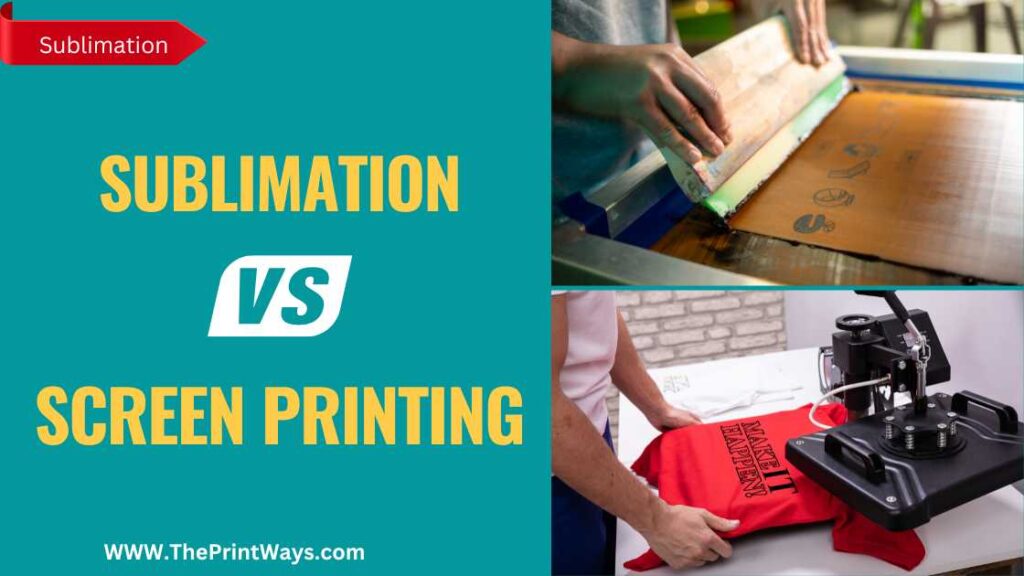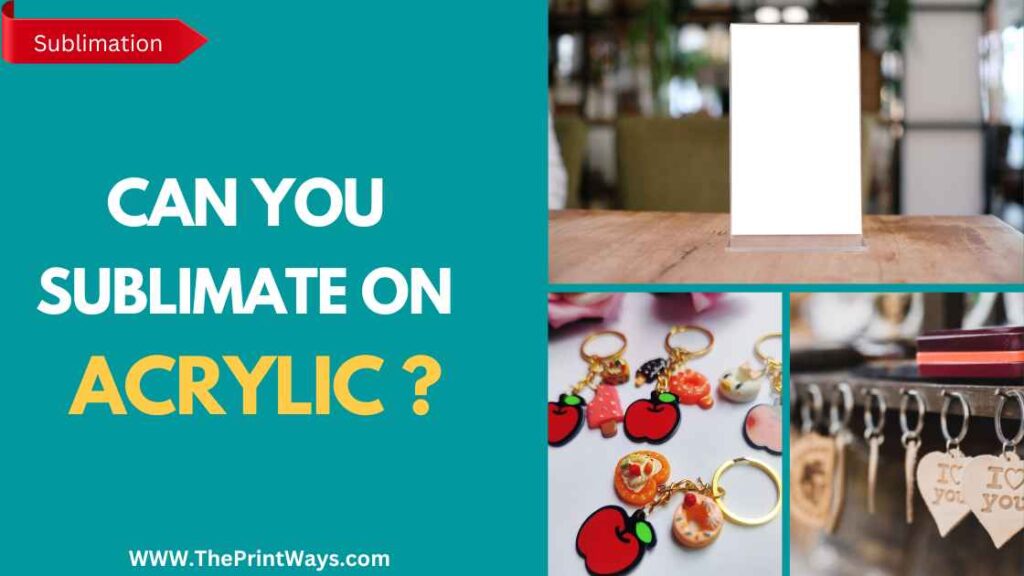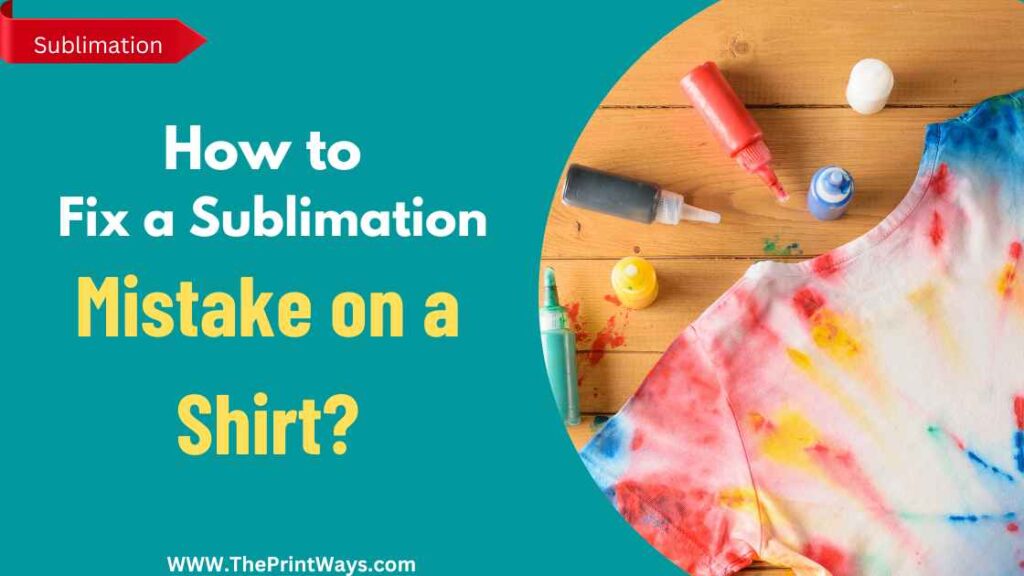Are you looking to customize clothing or other items with personalized designs? You may be wondering what the best printing technique is for your project.
Sublimation and screen printing are both popular methods, but which one should you choose?
In this article we’ll discuss the differences between sublimation vs screen printing so you can make an informed decision about which process fits your needs best.
Sublimation Vs Screen printing: Whats the Difference?
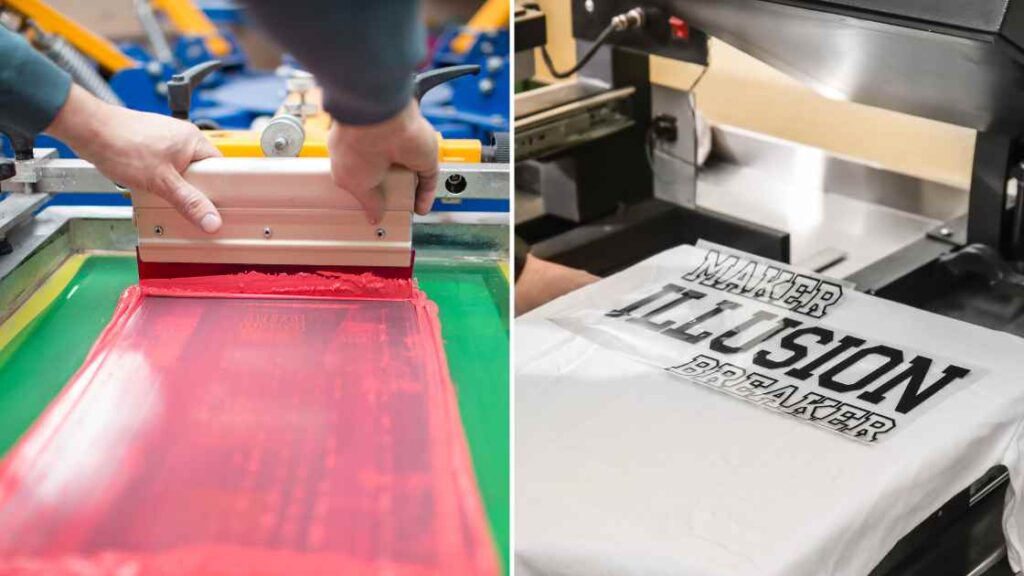
Sublimation is the process of transferring a design onto fabric, paper or other mediums using ink and heat. It involves printing an image onto transfer paper using sublimation inks, then laying the transfer paper on top of a fabric surface and pressing it with a heat press to dye-sublimate the ink into the material.
Screen printing, also known as silk screening, is another type of printing method for items such as t-shirts, signs and other materials.
This process employs a woven mesh stencil placed over a substrate that contains individual colors used in your artwork. Ink is pushed through the fine holes in each color layer by means of squeegees to create images on textiles or flat surfaces.
Materials Used For Sublimation Printing
Sublimation printing is a process in which heat and pressure are used to transfer dye onto a substrate. The material used in sublimation printing is a special type of ink called sublimation ink.
Sublimation ink is made up of dyes that have a high vapor pressure, meaning they can turn from a solid into a gas without going through a liquid phase.
When the ink is heated to a high temperature, typically around 400 degrees Fahrenheit, it turns into a gas and then bonds with the substrate, usually polyester or other synthetic fabrics.
In addition to the ink, sublimation printing requires a specialized printer that uses a heat-sensitive transfer paper to transfer the design onto the substrate.
The transfer paper is printed with the mirrored image of the design using sublimation ink and then placed on top of the substrate, with heat and pressure applied to bond the ink to the fabric.
Materials Used For Screen Printing
Moving on from sublimation printing materials, let’s take a look at what is required for screen printing. Screen printing requires fabric specifically made for the process, as well as ink and mesh screens.
The types of fabrics used in screen printing are typically natural fibers like cotton or linen, though synthetic blends can also be used. Generally speaking, heavier-weight fabrics are better suited to this method than lighter ones.
Inks must be chosen carefully too; they come in many forms such as water based pigment inks, plastisol (plastic-based) inks, solvent-based inks, discharge inks and more.
Also Read: DTF Vs Sublimation: Which is better?
Sublimation Vs Screen printing: Ink Comparison
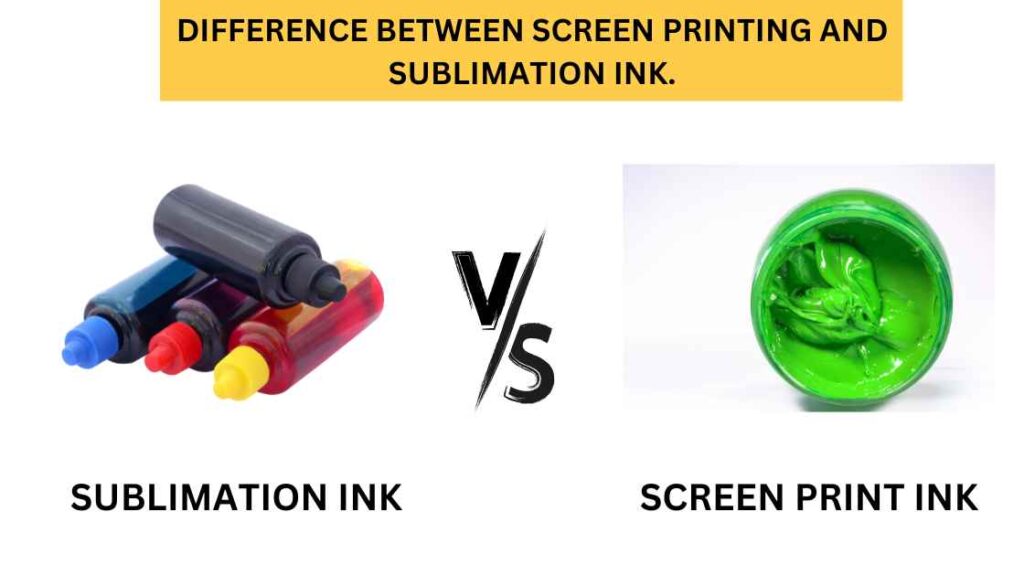
Sublimation printing and screen printing differ in their ink types and application processes.
– Sublimation ink is a dye-based ink that is designed to turn into a gas when heated and create a bond with the substrate. This ink is typically used for printing on polyester and synthetic materials, producing bright, vibrant colors that are long-lasting and do not crack or fade over time.
Sublimation ink is also capable of producing photo-quality prints, making it a popular choice for personalized gifts and promotional items.
– In contrast, Screen printing ink is a thicker, more opaque ink that is applied to the substrate using a stencil and mesh screen. This type of ink is more versatile and can be used on a wider range of substrates, including natural fibers like cotton, as well as plastics, metals, and glass.
Screen printing ink is available in a variety of colors, including metallic and fluorescent options, and can be applied to create bold, eye-catching designs.
Related: Can you use Sublimation Ink for Regular printing?
Color Vibrance & Quality
Now that we have discussed ink types for screen printing, let’s explore color vibrance and quality. Vibrant colors can be achieved with both dye sublimation and screen printing. The difference lies in the type of ink used as well as the transfer method to get it onto a garment or other material.
Dye sublimation uses an advanced process where water-based dyes are printed directly into the fabric from a digital printer using heat transfer paper.
This technique allows for high vibrancy because of the special formulation of these inks which bonds with the fibers of the fabric producing lasting results.
Screen printing is another popular way to achieve vibrant colors on garments and materials. It involves transferring images onto surfaces with specialized screens and then adding layers of colored ink over top before drying by heat setting.
Although not as bright as dye sublimation, this method still produces great looking designs with a consistent level of vividness across all prints.
Cost Considerations
When considering cost, both sublimation and screen printing have pros and cons. Sublimation is often more expensive than screen printing up front due to the specialized equipment required.
However, because it requires fewer steps in the production process, overall costs can be reduced over time with larger orders. Screen printing has a lower initial setup fee but may require additional costs for multiple colors or complex designs.
Also Read: What is Monochrome Printing?
Design Limitations Of Sublimation
When it comes to design, sublimation has its own limitations. For starters, the printing resolution of a sublimated image is usually lower than that of other printing techniques like screen printing. This means that details in an image may be lost during the transfer process.
In terms of production time, sublimation takes longer than traditional methods such as screen printing because multiple steps are involved in creating each piece.
Design Limitations Of Screen Printing
Moving on from the design limitations of sublimation, it’s time to look at its counterpart — screen printing. As with any other print technique, there are certain design complexities and intricacies that can limit what is possible for a given project.
Generally speaking, when compared to sublimation, screen printing has higher levels of complexity and intricacy when it comes to designing projects.
When creating designs using screen printing, many factors must be taken into consideration such as material choice, color selection, application method, drying time and so forth.
All these considerations can make it difficult to create intricate designs in terms of detail or color gradients due to overlapping colors or the need for multiple screens in order to achieve the desired effect.
Production Time Comparison
Sublimation and screen printing are two popular methods of garment decoration. When comparing the production time for each method, sublimation is much faster in terms of turnaround time.
The production speed of a sublimation print job can be completed within minutes while the same size order with screen printing can take hours to finish.
As such, when a customer needs their order quickly, they may opt for sublimation over screen printing as it has a shorter overall print time.
You May Like: How to Convert a Canon printer to Sublimation?
Durability Comparison
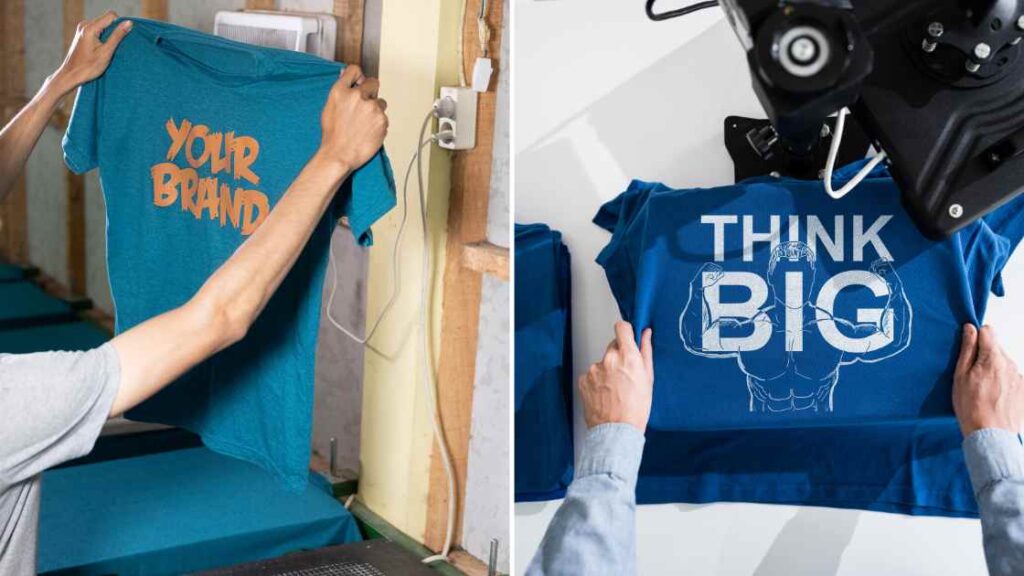
When it comes to durability, sublimation printing and screen printing both have their strengths. Sublimation is known for its long-lasting results. It utilizes heat transfer onto various surfaces, allowing the ink to bind with the material for a strong bond that won’t fade over time.
On the other hand, screen printing uses an emulsion process which helps create thick layers of ink that can withstand wear and tear much better than traditional methods like digital printing or laser engraving. Both techniques are capable of producing incredibly strong prints that will last for years without fading.
The main difference between these two processes lies in the materials they use. With sublimation printing, only certain types of fabrics are suitable while screen printing works best on thicker materials such as paper or cardstock.
Benefits & Advantages Of Each Method
Sublimation and screen printing are two popular methods for transferring artwork onto fabric. Each method has its own benefits and advantages, so it is important to understand the differences between them in order to determine which one would be best suited for a particular project.
The main benefit of sublimation is that it provides vibrant colors with superior detail compared to other processes. Additionally, this method requires no setup fees or minimum orders, making it an ideal choice if you want only a few items printed quickly.
The downside of sublimation is that it can only be used on specific materials such as polyester fabrics or ceramic mugs.
Screen printing offers many different options when it comes to customization, including color choices and ink types. It also allows for larger runs than sublimation does and produces long-lasting results that won’t fade over time. However, due to the complexity of setting up screens for each job, there are typically high set up costs associated with this process.
When deciding between these two methods, consider your budget, timeline requirements and desired output–all of which should play into your comparison of the benefits and advantages offered by each option.
Which Method is Right for you?
After comparing the benefits and advantages of sublimation vs screen printing, it’s time to consider some final considerations before deciding on which method is right for you.
Sublimation has several pros that make it a great choice. It requires fewer steps in production than screen printing, resulting in cost savings. Additionally, since no screens are necessary, there are minimal environmental impacts associated with this process.
On the other hand, screen printing does have its cons. The setup costs can be high due to the need for screens and ink setup fees, as well as more labor involved when setting up multiple colors or graphics.
Also Read: Why is My Sublimation Faded ?
These factors can often negate any savings from ordering large quantities of an item. Screen-printed designs also tend to not last as long as those produced through sublimation because the dyes penetrate so deeply into the fabric or substrate material used in this process.
Ultimately, it comes down to product longevity versus upfront costs when determining which method is right for you and your needs.
If you’re looking for something that will stand up to wear and tear over time and maintain vibrancy without breaking the bank then sublimation may be your best bet; while if price point is most important then screen printing should be considered first instead.
Frequently Asked Questions
Q: Sublimation Vs Screen printing: Which is Better?
The choice between sublimation and screen printing depends on your specific printing needs and the materials you’ll be using. Sublimation is ideal for producing high-quality, photo-realistic prints on polyester and synthetic materials, while screen printing is better suited for a wider range of substrates and can produce opaque, vivid designs.
Q: What materials are best for sublimation printing?
Sublimation printing works best on polyester and synthetic materials that can withstand high heat and pressure. This includes items like t-shirts, hats, mugs, and phone cases.
Q: Can you use screen printing ink for sublimation printing?
No, screen printing ink is not suitable for sublimation printing. Sublimation ink is a special type of dye-based ink that turns into a gas when heated and bonds with the substrate, while screen printing ink is a thicker, more opaque ink that is applied using a stencil and mesh screen.
Q: How does sublimation printing compare to screen printing in terms of cost?
Sublimation printing can be more expensive than screen printing due to the cost of specialized equipment, such as a sublimation printer and heat press. However, sublimation printing is more cost-effective for smaller print runs or designs with multiple colors, as there is no additional setup or screen fees.
Q: Which is more durable: sublimation or screen printing?
Sublimation printing produces long-lasting, vibrant prints that won’t crack or fade over time. Screen printing can also be durable if the ink is applied correctly and the substrate is cared for properly. However, sublimation printing is typically more durable on polyester and synthetic materials.
Conclusion
In conclusion, when it comes to printing on fabric, there are two main methods that can be used: sublimation and screen printing. Both methods have their own limitations in terms of what type of designs can be produced; however, generally speaking, sublimation produces more vibrant colors than those created with screen printing. Ultimately which method you choose depends on your budget and needs, but both options offer great results if done correctly.

